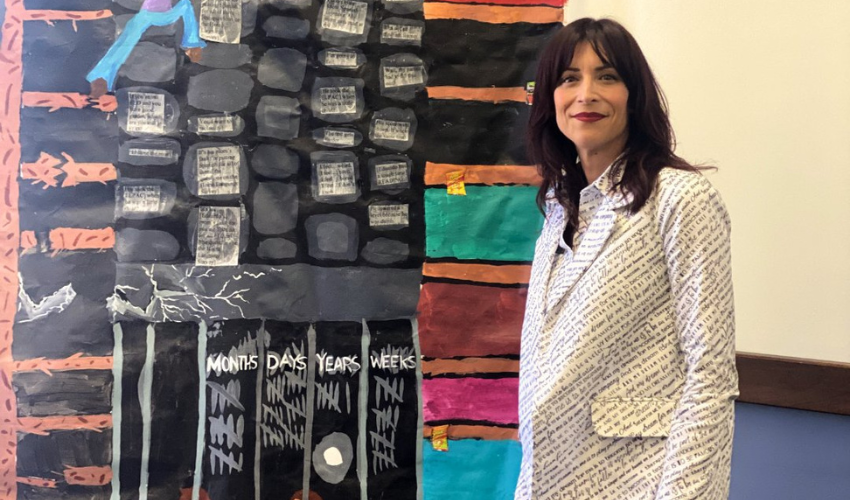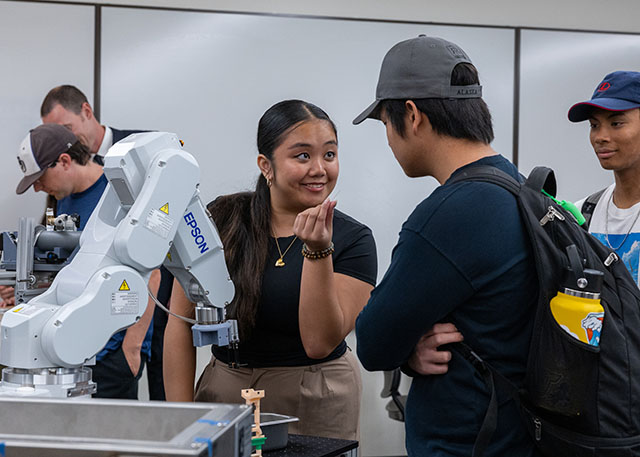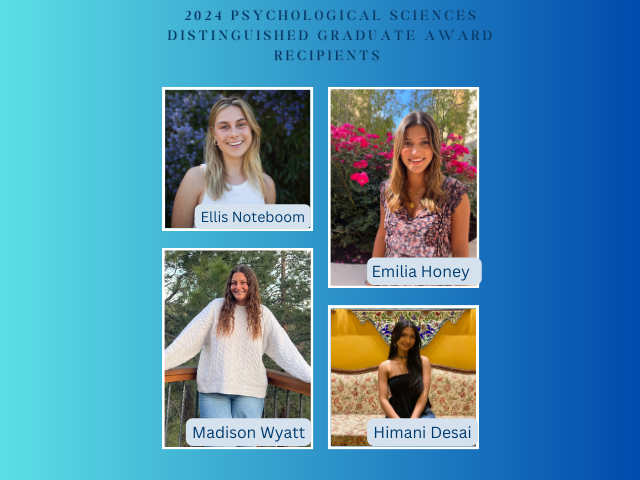PhD in Education for Social Justice Gives a Voice to Bi/Multilingual Students

In March, Zulema Reynoso was the first PhD in Education for Social Justice at the School of Leadership and Education Sciences (SOLES) to defend her dissertation, Resilient Resistance and (Re)Imagining Through YPARt.
Reynoso’s research focuses on how an educator and 20 seventh-grade bi/multilingual Latino students labeled as Long-Term English Learners (LTELs) reimagined how language is perceived, taught and assessed across traditional schooling contexts and language policy landscapes.
Some of these students helped Reynoso present her research at the SOLES 6th Annual Diversity Inclusion and Social Justice Excellence Showcase on Wednesday, April 19 as a part of the University of San Diego’s Research Month.
We spoke to Reynoso about her research, her findings and how her work continues to support bi/multilingual students.
What was your journey to the University of San Diego?
I was born in Tijuana, Mexico, and moved to Los Angeles where I spent most of my childhood. I moved to San Diego for high school and I remember my team debate cronies and I would always talk about attending different law schools, thinking that the University of San Diego (USD) was a lovely local option. I ended up going to art school and worked in museums before settling on a career in education. My connection to schools, however, was ongoing since I funded my undergraduate and graduate studies by working as a bilingual instructional assistant during the day and attending classes in the evenings. Eleven years ago, I moved back to San Diego from New York and began working with districts as well as educational technology companies, to support multilingual learners. After nearly 30 years of serving multilingual learners from Los Angeles, South Bronx, Manhattan, Brooklyn and San Diego, I was called to USD by the promise of a new doctoral program that was firmly grounded in social justice. Unlike other doctoral programs I had considered, the PhD in Education for Social Justice program emitted an unparalleled authenticity about its convictions to change the way we do education.
What is your research focused on and why did you choose this topic?
My research topic focused on elevating the voices of a specific subgroup of English learner (EL) students who are known as Long-Term English Learners (LTELs). These are multilingual students who, despite having been educated in U.S. schools for six or more years, have not been reclassified to English fluent status.
These students endure labeling, tracking, and testing microaggressions that dismiss their rich linguistic repertoires while prioritizing standard English as a marker of academic belonging and success. As a result, LTEL youth go into high school having to take non-credit-yielding courses, such as more English Language Development courses, and are denied access to electives and high-quality learning opportunities enjoyed by non-English learners. Each year, they are forced to take the standardized test known as the English Language Proficiency Assessment of California (ELPAC) and stand no hope of getting off the English learner track until they pass, even though many of their non-EL peers who struggle with language and literacy also likely would not pass. No other test exists with this kind of absolute power over a student’s whole being. The fact that this test specifically controls and negatively impacts the futures of multilingual students of color in California is a huge problem.
I was drawn into this topic approximately 10 years ago while working with a small group of fifth-grade English learners at a school near the Tijuana border. We were looking at their data together for the first time and most did not know that they were English learners. They also did not understand why they were given an additional English language test each year. As my students grew indignant about their grim data and asserted that they in fact already knew English, one of my quietest students emerged from her hooded coat with tears in her eyes and asked, “But we’ve been here since kindergarten. What happened?” This struck me to my core and I have since made it my life’s mission to answer her question and to dignify her voice along with all other youth voices by opening up more spaces for eliciting, listening, and responding to the lived experiences of multilingual youth.
What were you aiming to learn from this study?
There were three parts to my study. The first was related to how I might create an affirming English Language Development (ELD) space. Since daily ELD classes are policy-mandated and usually take shape as reductive test-prep spaces or additional daily doses of English Language Arts instruction, I wanted to see what would happen if we let students drive their own learning by shaping our instructional materials and activities through unfettered discourse, or casual pláticas or (informal conversations) about why they are in an ELD class, how they feel about the English Language Proficiency Assessment of California (ELPAC), and whether they agree with how they have been positioned in schools. I was especially curious about how a discourse of youth resistance might emerge if we interrogated the many systemic obstacles LTELs must traverse.
The second part of my study picked up on mobilizing their resistance for youth participatory action research (YPAR). I was curious to learn about the topics that resonated most with youth surrounding the ELPAC and how they would go about designing and deploying their inquiry projects. In the third part of my study, I wanted to see how youth might use the arts to transmit their study findings through expressive projects such as painting, design, theater, and poetry.
Because the heartbeat of my study was about building relationships and honoring youth voices in participatory ways, the crux of this work was dialogic and arts-based, not only in terms of the activities we did, but also in terms of how I designed and deployed my study. By integrating the arts into my research, I wanted to see if I could blur the hierarchical relationships between teacher/student and researcher/participant. Across all three phases of my study, I set out to use comics as a way to draw out our pláticas in affirming and dignified ways where youth would not only see their actions and words memorialized in cartooned vignettes, but they would also be invited to engage with my own researcher meaning-making. I wanted to explore the possibilities of using comics for drawing us closer together, both figuratively and literally, to strengthen relationships and to memorialize our time together.
What are the key findings of your research? Were any of these findings surprising to you?
Through specific pedagogical moves that tapped into youth resilience and resistance within English Language Development spaces, I found youth participants spoke freely, knowledgeably, and agentively when a cycle of eliciting, memorializing and reflecting occurred through pláticas and comics. My findings also demonstrated that when youth engage in inquiry after understanding that they are knowledgeable and free to express their meaning-making in safe and nurturing spaces, they can be poised to exercise their agency through political praxis and art-making.
Something that surprised me was that I did not expect youth to become so politicized and I certainly did not expect they would be so passionate about wanting to transmit their knowledge to others. After sharing their research with politicians and community educators, they have become insatiable about presenting their work to anyone who will listen. These students even co-presented with me at the 6th Annual Diversity Inclusion and Social Justice Excellence Showcase on Wednesday, April 19, 2023.
Why did you select qualitative research and why did you focus your research on seventh grade bi/multilingual Latino students?
I selected qualitative research because it aligns with my commitments grounded in Latina/Chicana Feminisms that reframes knowledge, believes in the power of marginalized voices, and has a certain sensibility about ways in which we can claim to come together. The specific use of pláticas (informal conversations) from Chicana Feminisms, especially with young people, are powerful relational practices that invite pedagogies of care, honor the legitimacy of lived experiences, and draw from knowledge imparted in students’ homes beyond school walls. I also selected qualitative methods because they accommodated my desire to incorporate unconventional art methods into my data collection and analysis processes, specifically comics-based research practices.
How can your research help us improve as a society and why is this research important right now?
Anytime we can elevate the voices of youth, especially Latino multilingual youth, it will benefit society immensely. Adults, politicians, educators, and researchers all tend to get in the way of youth imagination and their lived realities. They all think they know what is best for these young people without putting in the time to walk alongside them, listen to them, and trust them enough to let them take the lead. When one youth team spoke with a state assemblymember, he remarked how he had no idea there was a problem of transparency with the way Home Language Surveys are administered when students are first registered in schools. He listened to the firsthand accounts of students who are experiencing harm because their parents did not receive adequate information about how to fill out the form. He pledged to take this information with him in preparation for his next legislative session. The youth team did an excellent job preparing for this meeting and knocked it out of the park.
It is important to recognize that multilingual learners, especially those labeled as LTELs, are incredibly complex. I worked with three groups of students, engaged in the same activities across each section, and still ended up with three completely different inquiry and action projects. It is a testament to the nuanced identities within a group and how each young person matters and deserves to be seen and heard. We spend so much time trying to rebrand old ideas, create novel asset-based labels and other bizarre solutions for multilingual youth that appeal only to the adults who created them. The fact is, kids don’t care what you call them. I know because each time I tried to use one of the asset-based labels, they kept referring to themselves as English learners. They will tell you it’s not the label they care about. They just want to be in the same classes as their friends, made to feel successful, and be given the respect and dignity they deserve. More important, they want a teacher who genuinely cares, listens to them and trusts them. And they want to make art. There’s a great classic film from 1976 called “Bugsy Malone” that really captures the spirit of youth agency and brilliance when kids are in charge. I often think about that film and how the world might be a better place if young people were afforded more agency and opportunities for creative expression.
Having completed your research, is there a new question that you would like to set out and answer?
I would like to dig even deeper into the research projects the youth teams created and see if we can try to expand our action efforts. I found that only in the company of youth — who are inherently inventive, intelligent, and resilient — can we locate the loopholes, design the hacks to succeed, and share them with our communities.
What draws you to research?
I have always enjoyed research. I have been exploring, theorizing and sketching my meaning-making in art journals since I was a kid. My mind is constantly processing various phenomena and dreaming up research designs. Doing research with youth, however, is a total game changer. They blow my mind with ideas and concepts I could never have imagined. I hope for more opportunities to do research alongside them and to continue learning from them.



